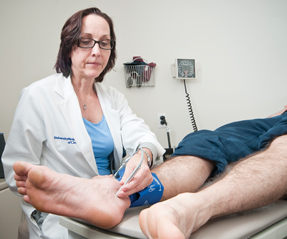Integrate mental health into medical practice
Partnerships between internists and mental health professionals are rare but proving their worth. Advantages include recognizing symptoms in a primary care setting and easing co-management for providers and patients alike.
The family physicians and internists at Jefferson University Hospital in Philadelphia used to have a simple response when they encountered a patient who needed mental health treatment.
“We have had little choice but to make this very important referral by asking the person to look up an 800 number on the back of their insurance card, dial that number, get an intake visit and hope it goes well. We usually say, ‘If you don't like the first person you meet, ask to try another one,’” explained Richard Wender, MD, chair of the family and community medicine department. “That's not a great way to do consultation,” he added.

A couple of years ago, Delaware County Professional Services (DCPS), a mental health practice, suggested co-locating and working together. Now primary care patients can be referred to a psychologist on the next floor instead of the back of a card. “It's just amazing what an impact that has,” said Dr. Wender. Physicians are more likely to make referrals and patients more likely to follow them, he explained.
Such partnerships are still relatively unusual, and face logistical and financial hurdles. Some primary and mental health care clinicians, however, are finding ways to come together for the benefit of their patients.
ACP Internist previously reported that screening for depression in primary care can necessitate close collaboration between both groups of clinicians (“Guidelines call for depression screening,” March 2010). But primary care practices face more mental health issues than depression, and federal grants and new practice models have opened up promising ways to integrate comprehensive mental health care and primary care.
In some cases, the impetus for collaboration has been the psychological needs of primary care patients, including not only treatment for mental illness but also assistance with behavior change. In others, mental health clinicians have found that their patients, who often have serious medical problems, had limited access to primary care. Whether they've come from medical or mental health backgrounds, the clinicians involved in these integrated practices have found a number of advantages to the setup.
The benefits
Dr. Wender said the DCPS relationship with Jefferson University Hospital “has expanded the number and variety of individuals who we will refer to behavioral health. Now we will refer patients who just aren't at their diabetes goal and are confronting some tough behavioral issues in day-to-day life—folks for whom we would probably not have expended the effort in the past.”
Once DCPS moved into the building with the primary care practice and agreed to see any or all of the medical patients (more on that later), it was easy for physicians to refer their patients for consultation and to know whether the patients followed through on their recommendation, since the clinicians were in regular contact.
Integration also increases the chance that patients will follow up—which is traditionally lower in mental health than in medical care—by reducing the stigma of mental treatment, according to Brian Bonnyman, MD, a family physician who practices at an integrated community health clinic run by Cherokee Health Systems in Knoxville, Tenn.
“I usually don't use words like psychologist. I usually say this is a specialist in your problem, such as insomnia,” Dr. Bonnyman said. The formal job title of the psychologists at Cherokee is behavioral health consultants.
Physicians at Jefferson also refer to their colleagues as behavioral health specialists, and encourage patients to see the practices as connected. “People really feel like they are coming here,” said Dr. Wender.
At Cherokee, the patients actually are coming to exactly the same place. “The waiting room for my patients and the psychologists' patients is the same,” said Dr. Bonnyman. “Often we will schedule follow-up at the same time to enhance compliance. A lot of times patients will want to see primary care. They don't really like the idea of seeing [the psychologist] but they'll put up with it if they're seeing primary care at the same time.”
The physicians and psychologists at Cherokee are located in adjoining rooms to facilitate collaborative care. “If I see a new patient and I think a prominent part of their problem is related to mental health, then I can just go next door and say, ‘Hey, could you please talk to this patient and assess them?’” said Dr. Bonnyman.
Referrals work in a similar way at Central Washington Family Medicine in Yakima, Wash. “The doctor will complete the medical portion of the visit and have me paged somewhere in the middle of that. We'll briefly do a curbside consult outside the exam room, he'll introduce me to the patient, and I'll take the patient to another space, because we don't want to tie up the exam rooms,” said behavioral health consultant Kirk Strosahl, PhD.
This meeting is obviously quite different from the traditional mental health visit. “What most patients need and what most of us as providers need are some brief, to-the-point issues for the patient to work on and assistance in opening up new resources for the patient. We don't need most of our patients to be going for an hour of therapy for the next six months,” said Russell Maier, MD, a family physician and program director of the residency program at the Washington clinic.
Although at Jefferson the psychologists see patients during appointments discrete from their medical visits, the setup is like the other integrated practices in that therapists often serve the patients by easing access to other mental health resources. “What they have done is develop a broader network of referral patterns and they work as a navigator,” said Dr. Wender.
Going the other way
Care navigation and coordination are key components of a current grant program from the Substance Abuse and Mental Health Services Administration (SAMHSA). Starting last year, the government agency now funds 56 sites around the country in their efforts to increase care integration. But this effort works the opposite way of the previously discussed programs: It brings medical care into clinics that were already providing mental health services.
“The big problem is that people with serious mental illness tend to not see a primary care provider,” said Trina Dutta, MPP, MPH, public health analyst for SAMHSA. The grantees have been given a fair amount of freedom to develop solutions to this problem. “We have some sites that are really aspiring to be what I would call a health home,” said Ms. Dutta. “Other sites are really focusing on how you do this handoff.”
As it turns out, mental health clinicians report obstacles handing off their patients to primary care that are similar to the ones primary care physicians have found.
“There's the issue of perceived stigma. Primary care providers just don't know what to do when someone with serious mental illness comes in their door,” said Ms. Dutta. “This population is fairly comfortable getting their care in the community behavioral health setting.”
Mental health clinicians may also have difficulty helping patients find primary care if they're uninsured or on Medicaid. “For psychiatrists, there is no mechanism to help patients access the general medical health care system. There is no mechanism for overseeing the continuity of care for their physical problems,” said psychiatrist Damian Kim, MD.
Dr. Kim practices at the Med/Psych Clinic at Coney Island Hospital in Brooklyn, N.Y. In 2009, the medical clinic was opened within the behavioral health clinic to provide primary care to existing patients.
“Because we are all physically together, the psychiatrist can call and say, ‘I have a patient who's with me now and is a little bit nervous about getting the physical. Can you just come up and meet them?’ We little by little begin to build the therapeutic alliance,” said Irene Pearlman, RN, clinical nurse program director of the clinic.
Like the psychologists consulting on the medical patients, the primary care clinicians will vary the structure of that first consultation depending on the needs of the patient. “We may not complete the initial evaluation in the first visit, like they do in the regular medical clinic. We may do part of the physical exam and ask them to come to the clinic when they feel more comfortable,” said Suneetha Chowdary, MD, an internist at the clinic.
The medical and mental health clinicians then join forces to accomplish goals of care. “We're all working together to get the patient to comply, to come to appointments. We're working together on the same goals in terms of their health. There's a lot of increased communication because we're all one team even though we might have different focuses and specialties,” said Ms. Pearlman.
In some integrated models, the cooperation and communication extend to the choice of treatment. “We'll put our heads together and create an integrated treatment plan. That might involve decisions about whether to start a patient on medication versus just working with behavior change, or some combination thereof,” said Dr. Strosahl.
Challenges and obstacles
This collaborative model can require some adjustments from participating physicians, Dr. Bonnyman noted. “A typical medical practice is based on the Lone Ranger model, where providers work in relative isolation in their own offices. It can be kind of threatening to work with other people, because you have to be open to learning new things,” he said.
Integration requires flexibility from all involved, said Dr. Strosahl.
“It actually requires a change in how the physician conducts the exam, because they have to think, there's an available resource here that I might otherwise have neglected to talk about or chose not to talk about because I didn't want to deal with it or couldn't deal with it,” Dr. Strosahl said. “On the mental health side of the fence, we were all trained to see people in the initial appointment for an hour and a half, write two- to three-page intake reports, set up treatment plans that involve hour-long visits.”
For mental health clinicians who are actually taking on aspects of primary care in the SAMHSA-funded clinics, the changes have been even greater. As part of the grant's mandate to screen patients for medical issues, for example, waist circumference measurements are being taken.
“You have to put your arms around the person's waist with the measuring tape and touch them,” said Ms. Dutta. “In the behavioral health world, there's not the culture of touching your clients. In many cases, people are not trained to touch their clients and in many cases the clients don't want to be touched.”
These differences in the culture of practice are usually resolvable through training and practice, though. The real obstacle to integrated care is the reimbursement system, the experts said. “It's so progressive and effective that no one wants to pay for it,” joked Dr. Strosahl.
The SAMHSA officials are encouraging participating clinics to start searching now for ways to fund their integrated programs after the grants end in three or four years. One of the possible avenues is for states to pick up the costs, especially if the programs prove to successfully reduce emergency department visits in their patient populations, Ms. Dutta said.
At Jefferson, integration relies on the willingness of mental health clinicians to see patients for free. “DCPS made a critical decision, without which this program would not have worked. They said, ‘We will see patients from any insurance type.’ This was extraordinary, but it's really what makes this system work. Without this, it becomes much more cumbersome,” said Dr. Wender.
For Medicare and Medicaid patients who need continuing mental health care, the psychologists connect them with other clinicians who have contracts with the government payers, including the health system's own department of psychiatry. When the psychologists see privately insured patients, they can bill for their services.
“There are some patients who are enrolling with them for longer-term care, so there is a business model there,” said Dr. Wender. “I think their sense is that it's at least a break-even proposition for them.”
The model could be copied by other large practices that find an amenable mental health provider, he speculated. However, small practices might have trouble maintaining enough volume, and all practices have to be careful about anti-kickback regulations. (Jefferson rents office space to DCPS to avoid this problem.)
There is another type of clinic that successfully covers medical and mental care. Dr. Wender said some of the best models of integrated behavioral health exist within federally qualified health centers [FQHC]. Specifically designed to provide comprehensive care, FQHCs have a reimbursement setup more conducive to integration than that of other private or public payers.
The Cherokee clinic is a FQHC and Dr. Bonnyman noted the irony that he had to leave his affluent private practice to find integrated care. “It's interesting to see how these folks who are so destitute and needy in some ways get better care than my affluent and insured patients did, because I can be sure they're seeing a psychologist regularly,” he said.
There is some potential for this dynamic to change, however. Cherokee has convinced some private payers to cover integrated care for the insured patients who are treated at the clinic. Once the insurers saw the improved clinical outcomes, patient satisfaction, and cost savings the model produced, they were willing to agree to payment strategies to support the care model, according to Dr. Bonnyman.




